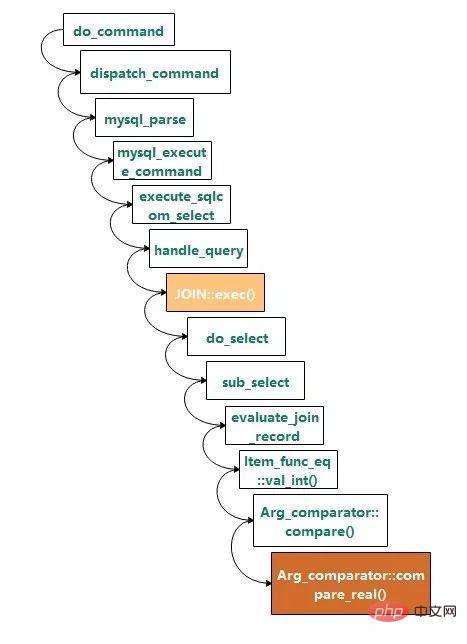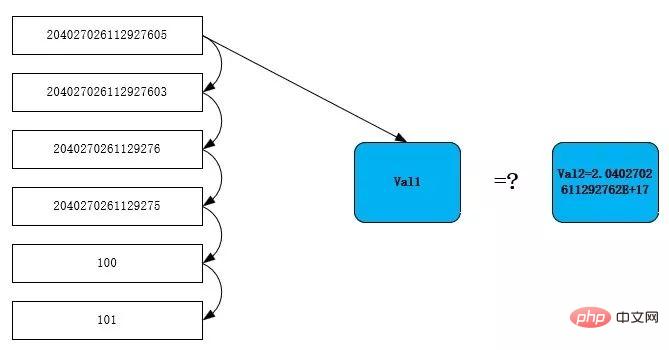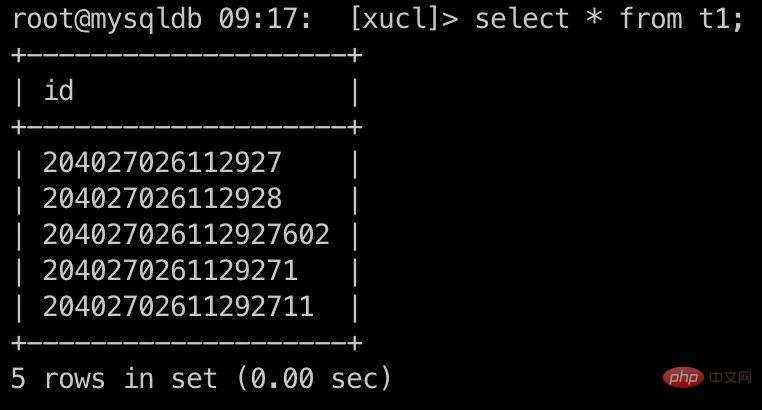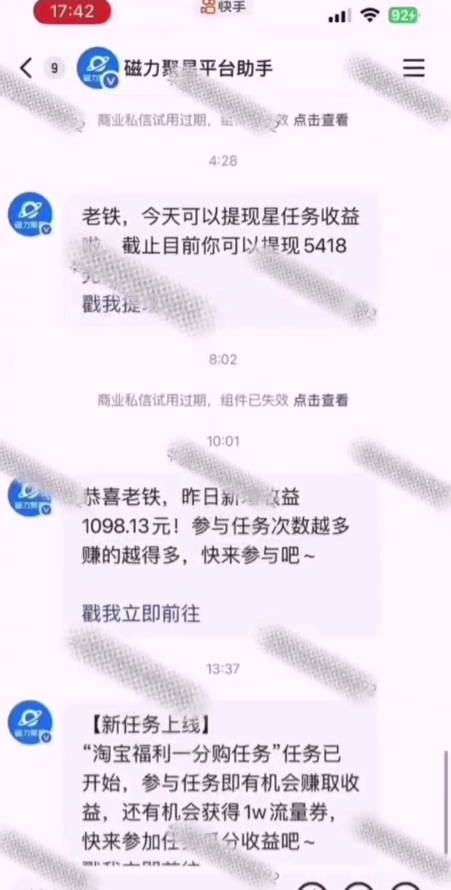mysql教程欄目介紹相關(guān)的隱式轉(zhuǎn)換

更多相關(guān)免費(fèi)學(xué)習(xí)推薦:mysql教程(視頻)
一、問題描述
root@mysqldb?22:12:??[xucl]>?show?create?table?t1G ***************************?1.?row?*************************** ???????Table:?t1 Create?Table:?CREATE?TABLE?`t1`?( ??`id`?varchar(255)?DEFAULT?NULL )?ENGINE=InnoDB?DEFAULT?CHARSET=utf8 1?row?in?set?(0.00?sec) root@mysqldb?22:19:??[xucl]>?select?*?from?t1; +--------------------+ |?id?????????????????| +--------------------+ |?204027026112927605?| |?204027026112927603?| |?2040270261129276???| |?2040270261129275???| |?100????????????????| |?101????????????????| +--------------------+ 6?rows?in?set?(0.00?sec)
奇怪的現(xiàn)象:
root@mysqldb?22:19:??[xucl]>?select?*?from?t1?where?id=204027026112927603; +--------------------+ |?id?????????????????| +--------------------+ |?204027026112927605?| |?204027026112927603?| +--------------------+ 2?rows?in?set?(0.00?sec)

什么鬼,明明查的是204027026112927603,為什么204027026112927605也出來了
二、源碼解釋
堆棧調(diào)用關(guān)系如下所示:

其中JOIN::exec()是執(zhí)行的入口,Arg_comparator::compare_real()是進(jìn)行等值判斷的函數(shù),其定義如下
int?Arg_comparator::compare_real() { ??/* ????Fix?yet?another?manifestation?of?Bug#2338.?'Volatile'?will?instruct ????gcc?to?flush?double?values?out?of?80-bit?Intel?FPU?registers?before ????performing?the?comparison. ??*/ ??volatile?double?val1,?val2; ??val1=?(*a)->val_real(); ??if?(!(*a)->null_value) ??{ ????val2=?(*b)->val_real(); ????if?(!(*b)->null_value) ????{ ??????if?(set_null) ????????owner->null_value=?0; ??????if?(val1?null_value=?1; ??return?-1; }
比較步驟如下圖所示,逐行讀取t1表的id列放入val1,而常量204027026112927603存在于cache中,類型為double類型(2.0402702611292762E+17),所以到這里傳值給val2后val2=2.0402702611292762E+17。

當(dāng)掃描到第一行時(shí),204027026112927605轉(zhuǎn)成doule的值為2.0402702611292762e17,等式成立,判定為符合條件的行,繼續(xù)往下掃描,同理204027026112927603也同樣符合

如何檢測(cè)string類型的數(shù)字轉(zhuǎn)成doule類型是否溢出呢?這里經(jīng)過測(cè)試,當(dāng)數(shù)字超過16位以后,轉(zhuǎn)成double類型就已經(jīng)不準(zhǔn)確了,例如20402702611292711會(huì)表示成20402702611292712(如圖中val1)


MySQL string轉(zhuǎn)成double的定義函數(shù)如下:
{ ??char?buf[DTOA_BUFF_SIZE]; ??double?res; ??DBUG_ASSERT(end?!=?NULL?&&?((str?!=?NULL?&&?*end?!=?NULL)?|| ??????????????????????????????(str?==?NULL?&&?*end?==?NULL))?&& ??????????????error?!=?NULL); ??res=?my_strtod_int(str,?end,?error,?buf,?sizeof(buf)); ??return?(*error?==?0)???res?:?(res?<p>真正轉(zhuǎn)換函數(shù)my_strtod_int位置在dtoa.c(太復(fù)雜了,簡(jiǎn)單貼個(gè)注釋吧)</p><pre class="brush:php;toolbar:false;">/* ??strtod?for?IEEE--arithmetic?machines. ? ??This?strtod?returns?a?nearest?machine?number?to?the?input?decimal ??string?(or?sets?errno?to?EOVERFLOW).?Ties?are?broken?by?the?IEEE?round-even ??rule. ? ??Inspired?loosely?by?William?D.?Clinger's?paper?"How?to?Read?Floating ??Point?Numbers?Accurately"?[Proc.?ACM?SIGPLAN?'90,?pp.?92-101]. ? ??Modifications: ? ???1.?We?only?require?IEEE?(not?IEEE?double-extended). ???2.?We?get?by?with?floating-point?arithmetic?in?a?case?that ?????Clinger?missed?--?when?we're?computing?d?*?10^n ?????for?a?small?integer?d?and?the?integer?n?is?not?too ?????much?larger?than?22?(the?maximum?integer?k?for?which ?????we?can?represent?10^k?exactly),?we?may?be?able?to ?????compute?(d*10^k)?*?10^(e-k)?with?just?one?roundoff. ???3.?Rather?than?a?bit-at-a-time?adjustment?of?the?binary ?????result?in?the?hard?case,?we?use?floating-point ?????arithmetic?to?determine?the?adjustment?to?within ?????one?bit;?only?in?really?hard?cases?do?we?need?to ?????compute?a?second?residual. ???4.?Because?of?3.,?we?don't?need?a?large?table?of?powers?of?10 ?????for?ten-to-e?(just?some?small?tables,?e.g.?of?10^k ?????for?0?<p>既然是這樣,我們測(cè)試下沒有溢出的案例</p><pre class="brush:php;toolbar:false;">root@mysqldb?23:30:??[xucl]>?select?*?from?t1?where?id=2040270261129276; +------------------+ |?id???????????????| +------------------+ |?2040270261129276?| +------------------+ 1?row?in?set?(0.00?sec) root@mysqldb?23:30:??[xucl]>?select?*?from?t1?where?id=101; +------+ |?id???| +------+ |?101??| +------+ 1?row?in?set?(0.00?sec)
結(jié)果符合預(yù)期,而在本例中,正確的寫法應(yīng)當(dāng)是
root@mysqldb?22:19:??[xucl]>?select?*?from?t1?where?id='204027026112927603'; +--------------------+ |?id?????????????????| +--------------------+ |?204027026112927603?| +--------------------+ 1?row?in?set?(0.01?sec)
三、結(jié)論
-
避免發(fā)生隱式類型轉(zhuǎn)換,隱式轉(zhuǎn)換的類型主要有字段類型不一致、in參數(shù)包含多個(gè)類型、字符集類型或校對(duì)規(guī)則不一致等
-
隱式類型轉(zhuǎn)換可能導(dǎo)致無法使用索引、查詢結(jié)果不準(zhǔn)確等,因此在使用時(shí)必須仔細(xì)甄別
-
數(shù)字類型的建議在字段定義時(shí)就定義為int或者bigint,表關(guān)聯(lián)時(shí)關(guān)聯(lián)字段必須保持類型、字符集、校對(duì)規(guī)則都一致
-
最后貼一下官網(wǎng)對(duì)于隱式類型轉(zhuǎn)換的說明吧
1、If?one?or?both?arguments?are?NULL,?the?result?of?the?comparison?is?NULL,?except?for?the?NULL-safe ?equality?comparison?operator.?For?NULL??NULL,?the?result?is?true.?No?conversion?is?needed. 2、If?both?arguments?in?a?comparison?operation?are?strings,?they?are?compared?as?strings. 3、If?both?arguments?are?integers,?they?are?compared?as?integers. 4、Hexadecimal?values?are?treated?as?binary?strings?if?not?compared?to?a?number. 5、If?one?of?the?arguments?is?a?TIMESTAMP?or?DATETIME?column?and?the?other?argument?is?a constant,?the?constant?is?converted?to?a?timestamp?before?the?comparison?is?performed.?This?is done?to?be?more?ODBC-friendly.?This?is?not?done?for?the?arguments?to?IN().?To?be?safe,?always use?complete?datetime,?date,?or?time?strings?when?doing?comparisons.?For?example,?to?achieve?best results?when?using?BETWEEN?with?date?or?time?values,?use?CAST()?to?explicitly?convert?the?values?to the?desired?data?type. A?single-row?subquery?from?a?table?or?tables?is?not?considered?a?constant.?For?example,?if?a?subquery returns?an?integer?to?be?compared?to?a?DATETIME?value,?the?comparison?is?done?as?two?integers. The?integer?is?not?converted?to?a?temporal?value.?To?compare?the?operands?as?DATETIME?values, use?CAST()?to?explicitly?convert?the?subquery?value?to?DATETIME. 6、If?one?of?the?arguments?is?a?decimal?value,?comparison?depends?on?the?other?argument.?The arguments?are?compared?as?decimal?values?if?the?other?argument?is?a?decimal?or?integer?value,?or?as floating-point?values?if?the?other?argument?is?a?floating-point?value. 7、In?all?other?cases,?the?arguments?are?compared?as?floating-point?(real)?numbers.
.jpg)

















.png)
